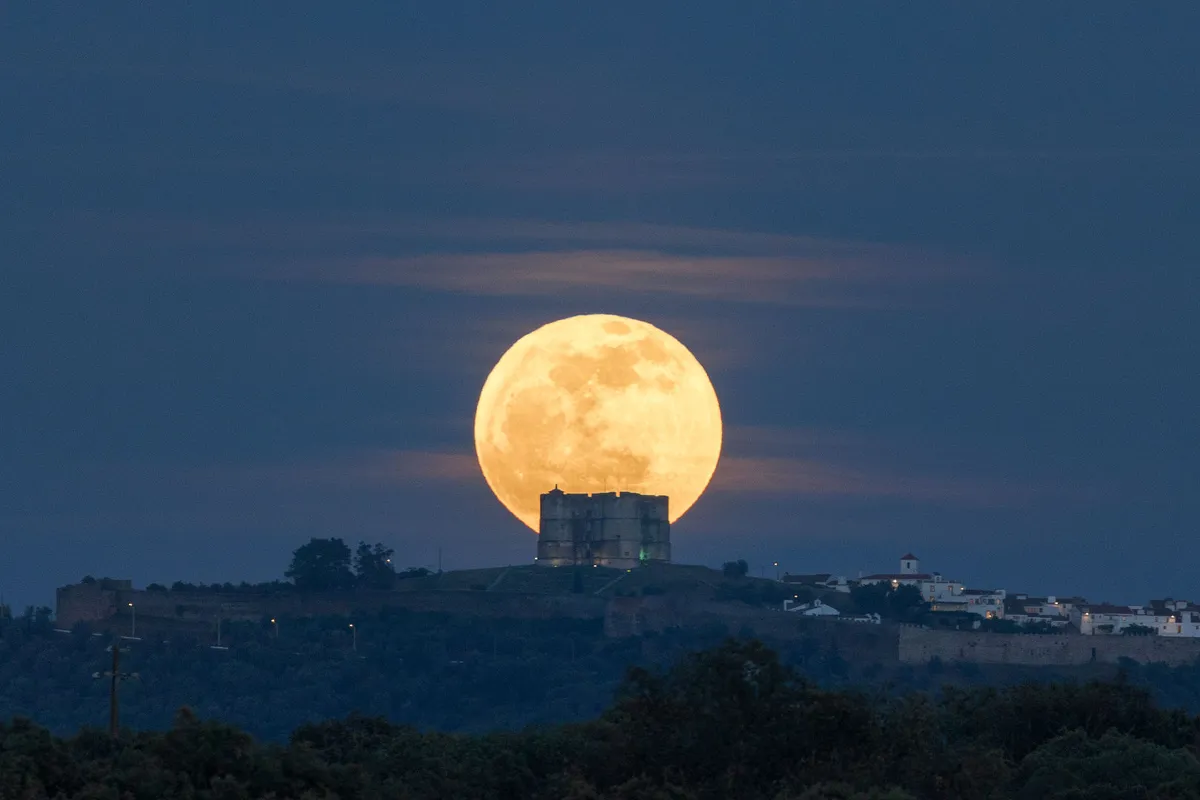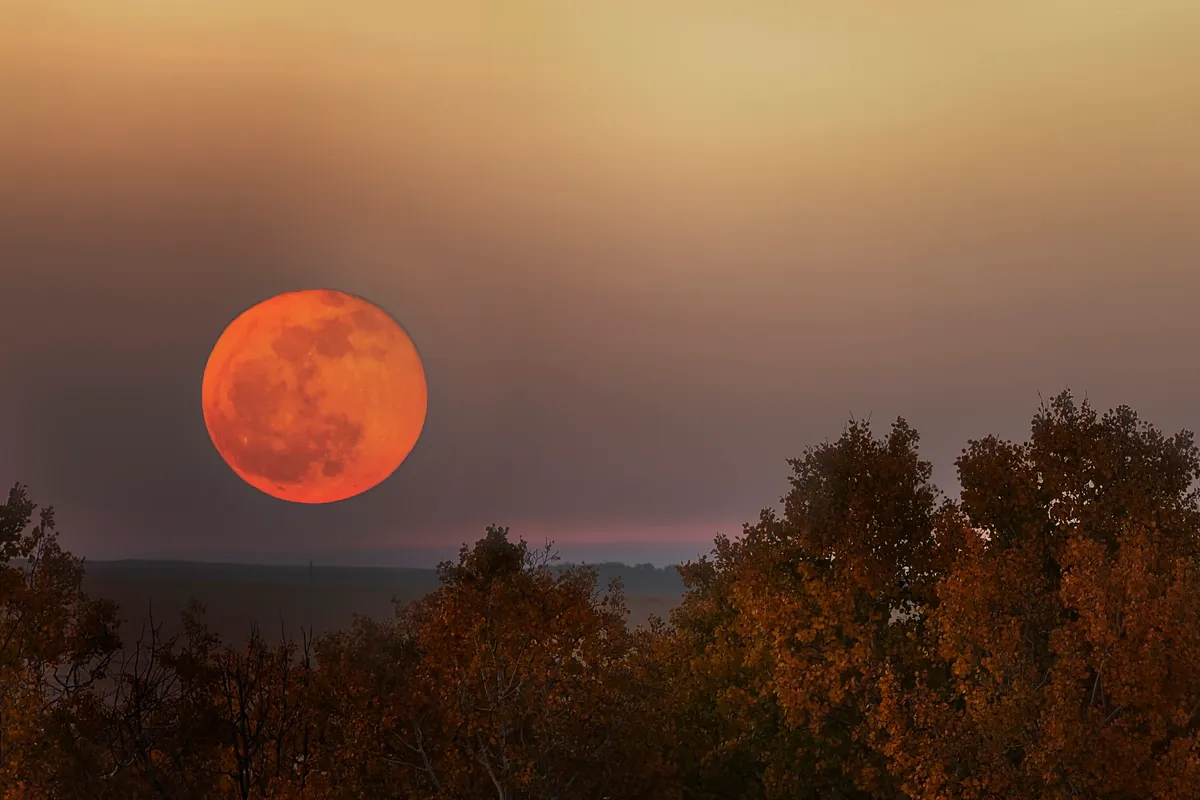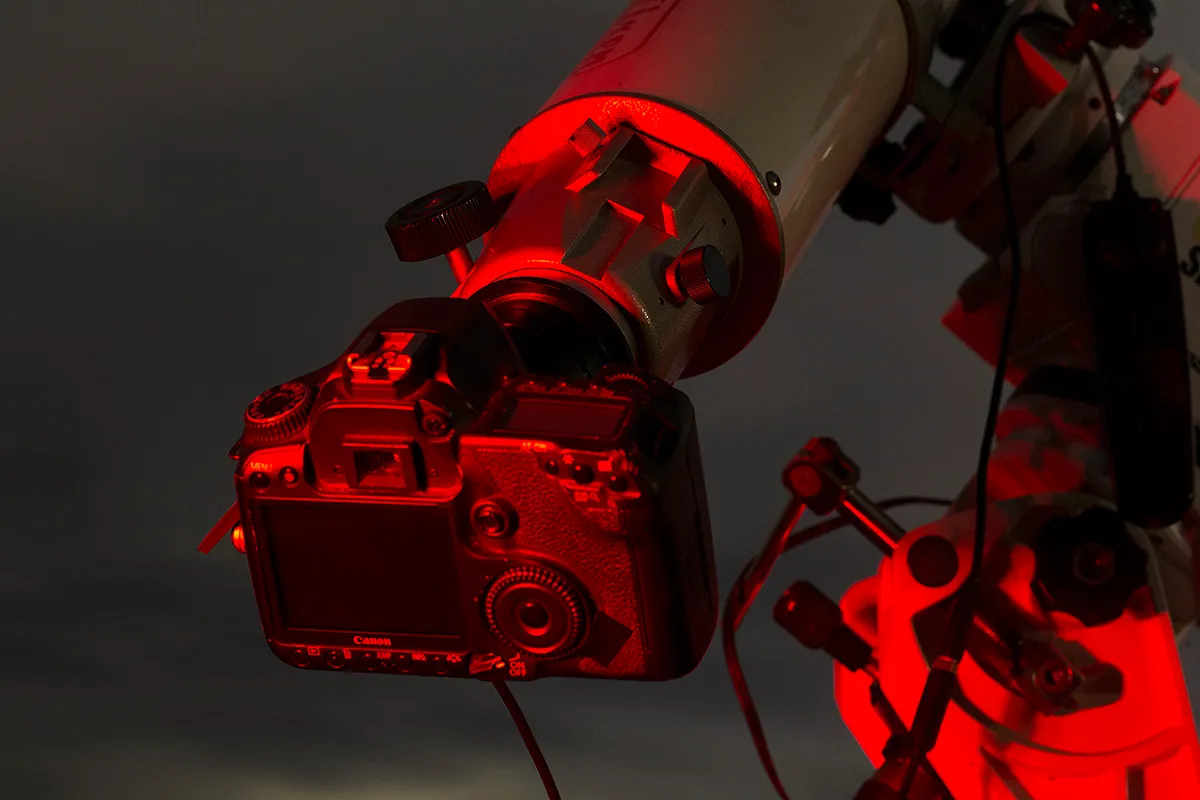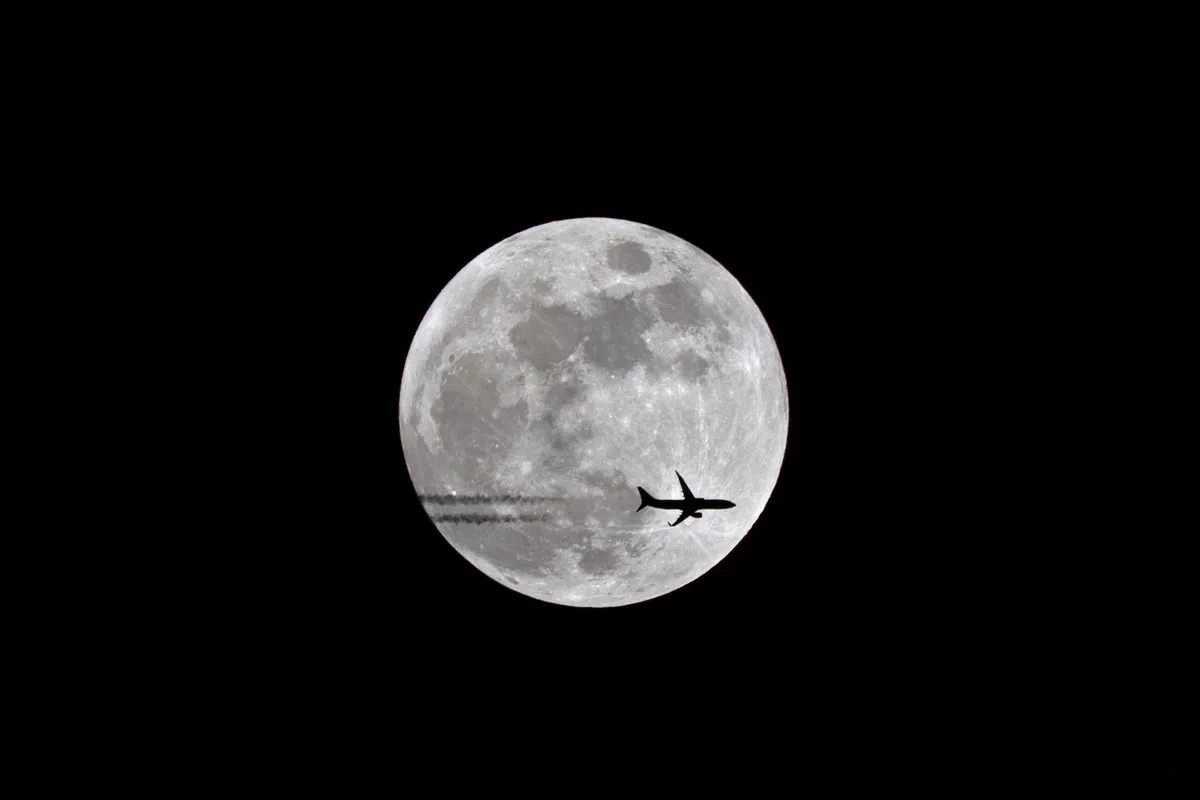Whether you live on a bustling city street or in a remote rural area, on flat terrain or surrounded by towering mountains, the rise of a full Moon rarely fails to make an impression.
Maybe it’s the element of the mystical that draws us to the sight – a fascination forged from millennia of watching our satellite’s dance across the night sky, combined with the strange little trick our brain plays on us by making the lunar disc appear larger when it’s near the horizon.
Whatever the reasons, this common event seems to be endlessly captivating.
Find out when the next full Moon is visible and get Moon phases and times sent to your email inbox every week by signing up to receive the BBC Sky at Night Magazine e-newsletter.
Read our full guide on how to photograph the Moon

Photographing a rising full Moon
For astrophotographers, the allure of a full moonrise has something of a dark side, not least because it requires overcoming technical, meteorological and planning issues while somehow still managing to convey the magic of the moment.
The first task for shooting this event is to work out both when and where the full Moon will rise.

Equipment: Canon EOS R mirrorless camera, Canon EF 100-400mm f/4.5-5.6L IS II USM lens
If you’ve not paid much attention to this element of celestial mechanics before, you might not know that the full Moon rises in different places along the eastern horizon at different times of the year.
Its azimuth at the moment it breaks the horizon varies greatly.
So before we even pack our camera bag we need to have a good idea of where to expect the lunar disc and what local topography will allow us to glimpse it there.
What makes or breaks a great full Moon photograph is the quality of your planning.
Thankfully there are many excellent resources that make this stage of imaging a breeze.

Pick your spot
The first place to start will be a decent planetarium programme like Stellarium or SkySafari.
With these you can find out the azimuthal position and timing of the full Moon rise for a given day.
You can then think of a suitable – and visually interesting – imaging location where you will have a good view of this part of the horizon.
All sorts of landscapes can make for a great full Moon rise photograph, from brightly-lit urban areas to tree-covered hills, open expanses and distant sea horizons.

Often the most powerful compositions include viewpoints with horizons many kilometres away, where the features on the skyline are shot with a longer focal length lens or telescope so as to appear small under the large Moon rising above.
To find the perfect perspective for your photograph of the full Moon, you may need to explore a few locations in daylight, far in advance of when you actually intend to image the moonrise.
Apps like the Photographer’s Ephemeris and PhotoPills can help here, as they can show you the direction that the Moon will rise, overlaid on a satellite map.
If you do make a site visit, take an accurate compass with you to check that you will definitely have a clear line of sight towards where you expect the lunar disc to appear.

Plan your full Moon photograph
One really important point that’s worth noting is that the timing of moonrise shown in a planetarium programme or in a published almanac won’t necessarily always match up with the actual moment that you’ll first spot the Moon on the night.
This has major implications for composing certain types of full Moon rise shot.
For example, if there’s thin haze or cloud on the eastern horizon, it might be 10–15 minutes after the published rise time that the lunar disc clears this layer and becomes visible.
What’s more, by the time it does appear it will have moved considerably from its ‘on-paper’ rising azimuth.
If you’re using a long focal length lens or telescope and are intending to frame the Moon with a faraway feature – like a gap in the trees or a far away hilltop – this shift could end up ruining your shot.
It might be worth having a plan-B composition in case the Moon doesn’t appear exactly where you planned it.

Consider field of view
The size of the field of view of your imaging setup will constrain how long you’ve actually got to snap the lunar disc over a landscape.
For example, an APS-C sensor DSLR and a 388mm focal length refractor, in portrait orientation – is about 3° in height.
Find out how to do this with our guide on how to attach a DSLR to a telescope.
This means that if I’m shooting a low horizon line and wish to include a decent amount of landscape in the shot, I have until the full Moon gets to an altitude of around 2.5° before the lunar disc starts to get too high and the composition starts to look unbalanced.
You can use Stellarium’s field-of-view plugin with your own kit specifications, and a simulation of the full Moon rising, to work out roughly how much leeway you have with your setup.

Get full Moon and the foreground right
As the twilight sky darkens, the level of foreground illumination lowers.
At the same time, the rising Moon becomes more visible against the dimming sky.
This means there’s a short period of time just after moonrise when the brightness difference between the lunar disc and the twilight-lit foreground is small enough to capture both well in a single shot.
Wait too long and the ‘dynamic range’ of the scene will be too great and you won’t be able to correctly expose both the shining disc and the landscape in the same image.
For wide-field images this can sometimes be overcome with a composite shot, taking several pictures then combining them in image-editing software.

But such techniques have to be done with care as they can look very unnatural if crudely executed.
At a minimum you will need to capture two exposures – one for the foreground and another for the Moon.
Avoid the temptation to expose the lunar disc perfectly. Aim for it to be quite a bit brighter than you would normally have it, as this will make for a more natural-looking composite.
Otherwise, when you copy and paste the disc into the correctly-exposed landscape shot in your chosen image editor, you can end up with a darker full Moon within a bright, glowing halo, which can look rather odd.
In my opinion, some of the most successful full Moon rise photographs are those where the lunar disc and foreground are recorded in one exposure.
If you agree, make sure you are in position at your imaging site in good time to take advantage of the narrow window where light levels are balanced after the Moon breaks the horizon.
But even if your timing or planning is a little out – or the weather conditions don’t cooperate to present the exact composition you were after – don’t be put off.
Next month will always, without fail, bring with it the chance to try it all over again.
Atmospheric effects on a full Moon photograph

There are several phenomena that can appear at moonrise that are just as rewarding to capture as the lunar disc itself, and including these in your photographs will really enhance them.
Perhaps the best example is the beautiful, but transitory, Belt of Venus.
This manifests itself as a pinkish swathe of sky low across the eastern horizon after sunset.
It’s caused by the rich reddened colours of the sunset scattering back at us off the atmosphere.
Below it you’ll also see a dark, grey-blue band, which is Earth’s shadow cast onto the sky.
Since both phenomena are seen in the eastern sky in the evening, it is common to see the yellowy disc of the full Moon rising through these colourful layers – something that can make for a really striking picture.

If you have a long focal length lens or telescope, and are imaging the moonrise up close, you may also be able to capture two other interesting optical effects.
When the full Moon is very low, refraction by Earth’s atmosphere gives the upper limb of the lunar disc a blueish-green edge and the lower limb a deep red rim.
Occasionally, if the atmospheric conditions along your line of sight to the Moon are just right, the upper greenish edge can sometimes be distorted by a mirage effect to produce a lunar green flash.
This rare occurrence appears as a fleeting green patch of light above the – typically rippling and undulating – upper limb of the lunar disc.

Photograph a huge full Moon close to the horizon
You will no doubt have seen images where the rising full Moon looks enormous against the foreground.
Many are works created by digital artists, while others are artificial composites.
Some, though, are genuine single-shot exposures of an apparently huge lunar disc looming over a horizon – perhaps a distant treeline, a city skyscape or people on a hilltop in silhouette, like on this issue’s cover.
How do astrophotographers capture these images where the full Moon looks enormous?
Two things are needed.
The first is that the photos are almost always created using a long focal length telescope, at least compared to most camera lenses.

For a full-frame format DSLR this might mean a scope around 1,000–1,300mm in focal length, while an APS-C sensor DSLR might only need a focal length of 600–800mm.
Shorter focal length scopes can still produce a similar effect but it won’t be as dramatic – unless you can crop the image – as the Moon’s disc will be smaller compared to the amount of earthly surroundings shown elsewhere in the frame.
The second factor is that you must image the foreground from a distance – not just a few tens of metres but a kilometre away, sometimes more.
This means the foreground and the rising lunar disc will be seemingly in the same plane.
With the tight field of view provided by the long focal length scope and no depth cues to signal that the foreground is far from the camera, you get perspective distortion and an apparently giant Moon rising materialises.
These images need careful planning and still, transparent skies close to the horizon to work well.
But if you can pull it off, the effort of setting up a telescope just for that brief moment of moonrise will often be rewarded by an absolutely spectacular final image.
If you capture a beautiful photograph of a full Moon, send us your images by emailing them to contactus@skyatnightmagazine.com
This article appeared in the February 2019 issue of BBC Sky at Night Magazine.

